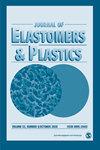Investigation of the usability of activated carbon as a filling material in nitrile butadiene rubber/natural rubber components and modeling by regression analysis
IF 1.6
4区 材料科学
Q4 MATERIALS SCIENCE, MULTIDISCIPLINARY
引用次数: 0
Abstract
Activated carbon is a versatile material with a wide range of applications due to its porous structure and large surface area. In this study, activated carbon was manufactured from cellulose using zinc chloride and phosphoric acid activation agents, and it was characterized using Brunauer-Emmett-Teller (BET), Field-Emission Scanning Electron Microscopes (FE-SEM), Energy Distribution Spectroscopy (EDS), mapping, and Fourier Transform Infrared Spectrophotometer (FTIR). Two different types of activated carbon utilized as a filler in Nitrile Butadiene Rubber (NBR)/Natural Rubber (NR) blends at different proportions (%0, %5, %10, %15 and 20%), and compared its properties to those of carbon black. The results showed that the addition of activated carbon improved the mechanical properties of the rubber blends, including hardness, tensile strength, and unit elongation. Furthermore, the experimental data obtained were used to examine the effects of carbon black, activated carbon salt, and activated carbon acid values on density, hardness, tensile strength, and percentage elongation variables using Multiple Linear Regressions (MLR). These models provided successful results in predicting the data with fewer experiments. The results have the potential to contribute to the promotion of the use of environmentally friendly materials in future research and to be an important step towards a sustainable industry.活性炭作为丁腈橡胶/天然橡胶组分填充材料的可用性研究及回归分析建模
活性炭是一种用途广泛的材料,由于其多孔结构和大表面积。本研究以纤维素为原料,以氯化锌和磷酸为活化剂制备活性炭,并利用brunauer - emmet - teller (BET)、场发射扫描电镜(FE-SEM)、能谱(EDS)、作图和傅里叶变换红外分光光度计(FTIR)对活性炭进行了表征。在丁腈橡胶(NBR)/天然橡胶(NR)共混物中以不同比例(%0,%5,%10,%15和20%)作为填料的两种不同类型的活性炭,并将其与炭黑的性能进行了比较。结果表明,活性炭的加入改善了橡胶共混物的力学性能,包括硬度、抗拉强度和单位伸长率。此外,采用多元线性回归(Multiple Linear regression, MLR)分析了炭黑、活性炭盐和活性炭酸值对密度、硬度、抗拉强度和伸长率的影响。这些模型在用较少的实验预测数据方面提供了成功的结果。研究结果有可能有助于促进在未来研究中使用环境友好材料,并成为迈向可持续工业的重要一步。
本文章由计算机程序翻译,如有差异,请以英文原文为准。
求助全文
约1分钟内获得全文
求助全文
来源期刊

Journal of Elastomers and Plastics
工程技术-材料科学:综合
CiteScore
3.30
自引率
5.90%
发文量
41
审稿时长
6 months
期刊介绍:
The Journal of Elastomers and Plastics is a high quality peer-reviewed journal which publishes original research on the development and marketing of elastomers and plastics and the area in between where the characteristics of both extremes are apparent. The journal covers: advances in chemistry, processing, properties and applications; new information on thermoplastic elastomers, reinforced elastomers, natural rubbers, blends and alloys, and fillers and additives.
 求助内容:
求助内容: 应助结果提醒方式:
应助结果提醒方式:


